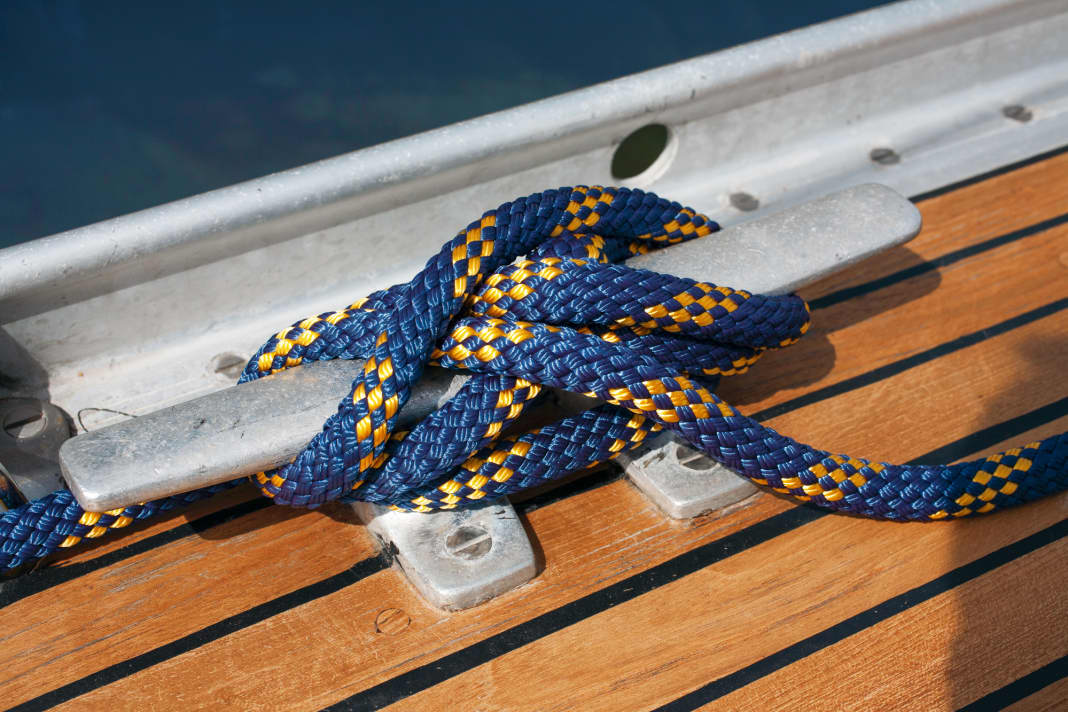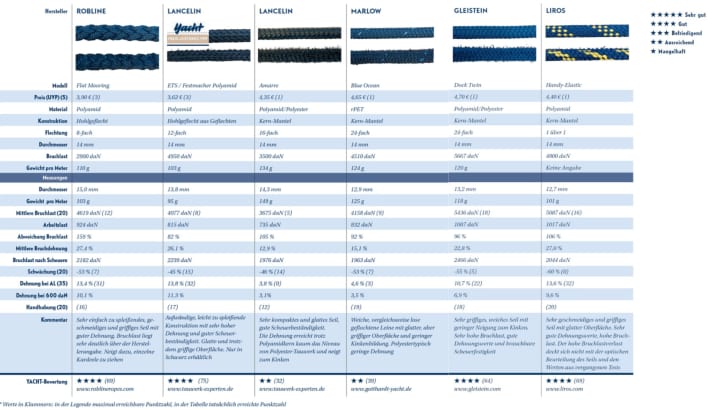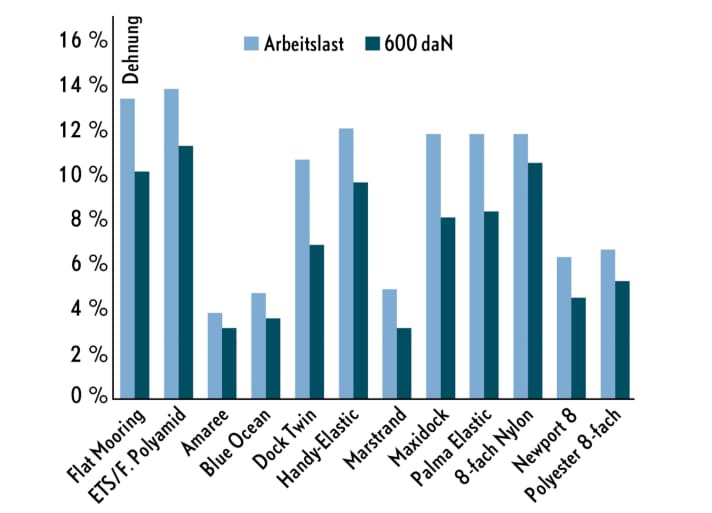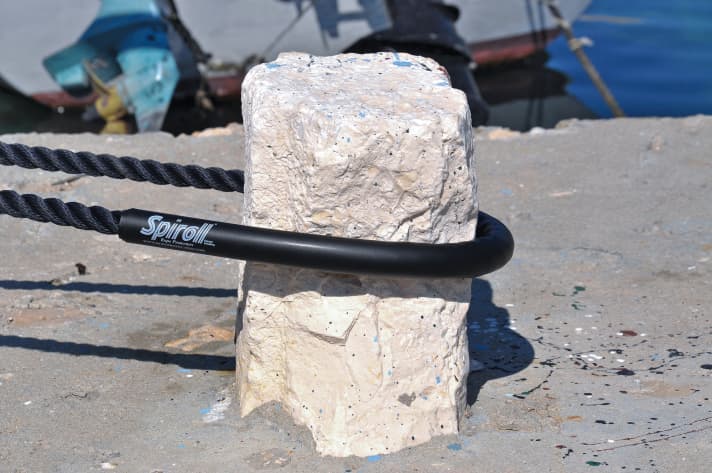





Although they are used practically every day, the mooring lines are easily forgotten. This may be because the crew is only concerned with them briefly when mooring and casting off. While a stubborn or worn-out genoa sheet comes to mind at every turn, the mooring lines at the bow and stern work and age almost under the radar.
The fate of the yacht depends on the lines for around a third of the year. In a typical northern European season, the ship is moored for around 160 days. On just 48 days - during the summer cruise and the night hours at weekends - at least the crew is on board.
Mooring lines put to the test: What the line has to do
Our last test in YACHT 13/2010 already showed that she shouldn't feel too safe. Above all, the enormous breaking load loss of the chafed lines was a warning to replace the mooring lines in good time. In the meantime, almost all manufacturers represented in Germany have brought new lines onto the market. An inspection revealed eleven new products from Gleistein, Lancelin, Maffioli, Marlow and Robline/Teufelberger, including six core-sheath constructions, two hollow braids and three squarelines. As a reference, we have added the Handy-Elastic from manufacturer Liros, which has been tried and tested for years and was rated well in the last test.
First and foremost, the rope must have sufficient strength to keep the yacht securely moored even in strong winds. It should also offer as much stretch as possible. The more energy the line can absorb by changing its length, the softer the boat jerks in the swell, which reduces the load on the cleats and makes it more comfortable to stay on board.
More about cordage:
However, none of this will help if the cordage loses its fibre the first time it comes into contact with a rusty iron ring, a cleat or the concrete quay. Abrasion resistance is therefore also a decisive factor. Here in particular, we were keen to see the results of the new products. In the last test, dramatic losses in breaking load occurred even with moderate wear.
Ropes: What material are good mooring lines made of?
In addition, the rope should be as supple as possible, as it should be easy to cover and shoot up. Kinking is also undesirable. Slip lines that do not run out cleanly quickly put the crew in trouble in strong crosswinds.
In order to fulfil these requirements as well as possible, manufacturers have been working for years on the combination of rope construction and material. In principle, two plastics can be considered for mooring lines: polyester and polyamide, also known under the brand name nylon, are the most suitable materials. Polypropylene, which is also available, is very cheap, but is also much more sensitive to light and abrasion. It therefore ages very quickly and becomes hard, which is why we have not included polypropylene cordage. It should only be used as a yacht mooring line if the line absolutely has to be buoyant.
We based the diameters on a virtual, ten metre long test yacht. A minimum breaking load of 3000 decanewtons was required, resulting in 14 millimetre thick lines. Only the flat mooring from Robline did not meet this specification according to the catalogue, but was nevertheless supplied in 14 millimetres. And rightly so - in the test, we determined an average breaking load of around 4600 decanewtons, a good 60 per cent above the manufacturer's specification and more than sufficient.
What breaking load and working load mean for lines- Differences
Pleasingly, none of the lines undercut the manufacturer's specification by more than 18 per cent, and as a rule the ropes were even able to withstand significantly higher forces. The largest downward deviation occurred with the ETS from Lancelin. However, with its 4077 decanewtons, the line is still very suitable for the test boat. The Maxidock from Maffioli lives up to its name, with more than 5600 decanewtons it has the highest breaking load in the test.
In practice, the breaking load of a mooring line only plays an indirect role; the working load is derived from it. According to the recommendations of the classification society DNV GL, it should not exceed 20 per cent of the breaking load, which corresponds to values between 735 and 1128 decanewtons for the test candidates. Higher working loads offer scope for mechanical damage to the rope.
To test the abrasion resistance, we chafed all the lines under exactly the same conditions as in the last test and then determined the breaking load of the damaged rope.
This cordage was convincing in the abrasion test
Lancelin's polyester Squareline exhibited the least damage, with just under 60 per cent of its original strength remaining. The worst performers were the Handy-Elastic from Liros and the Dock Twin from Gleistein, which lost 60 and 55 per cent of their breaking load respectively. Only the Maxidock from Maffioli still achieved the required breaking load or working load for our test boat after the abrasion test. The line only loses 44 per cent of its strength and has the necessary reserves thanks to its high breaking load.
The choice of material, i.e. polyester or polyamide, plays practically no role in the abrasion resistance, both plastics are roughly on a par. And there is also no clear picture when it comes to construction. Depending on the manufacturer, core-shell braids, hollow braids and squarelines sometimes perform better, sometimes worse.
One thing is particularly striking: the appearance is deceptive. The Handy-Elastic, which appears almost intact at first glance, lost 60 percent of its breaking load, so a lot of fibres must have been damaged, while the visually significantly impaired Maxidock only lost 44 percent.
How much can the tested mooring lines be stretched?
Ropes made of polyamide have a clear advantage in the elongation measurement, offering up to three times more stretch than polyester ropes. These differences were already apparent during the testing. While the polyester ropes could be pulled up to the breaking point in a single operation without any problems after the obligatory pre-tensioning, the polyamide products did not have enough travel for the tensile testing machine - it was so prolonged that we had to interrupt every tensile test and re-tension some of the batches several times. The nylon squareline from Robline has the highest elongation, it stretches by around 15 per cent under working load and also achieves the best values with our comparative load of 600 decanewtons. At the other end of the scale are the Amarre from Lancelin and the Blue Ocean from Marlow with 3.8 and 4.6 per cent respectively.
The low stretch of the Blue Ocean is due to the material; it is a rope made from recycled PET, i.e. polyester, which is obtained from empty drinks bottles. However, the poor performance of the Amarre is surprising. Its core is made of polyamide, so the rope should actually stretch a lot. Apparently, the relatively compact polyester sheath limits the stretch, which makes the rope behave like a pure polyester product.
If you have such lines on board, you have to reckon with hard jerks in swell. In any case, it is advisable to retrofit shock absorbers. Of course, both a stretchable rope and an additional rubber buffer in rough harbours would be ideal. The elongation values make polyamide rope the predestined mooring line, but this is countered by another material property: polyamide absorbs water, with the result that the fibres shrink. In practice, this means that The lines can become stiff and unwieldy after a short time.
The differences in the spliceability of the mooring lines
Whipped ropes harden particularly quickly; core-sheath braids and squarelines, on the other hand, are much less critical. Modern polyamide ropes therefore retain their suppleness for many years. To accelerate ageing, we stored the polyamide samples in a 65-degree water bath for five days. This stress test made the lines slightly stiffer, but there were no significant differences between the products.
The hollow braids and squarelines nestle best around cleats and bollards. However, they also tend to pull individual fibres out of the construction on rough surfaces. The flat mooring and the long braided squareline from Lancelin seem particularly susceptible. The core-sheath constructions also feel good in the hand and are easy to shoot. Only the Amarre from Lancelin is slightly less supple and tends to kink.
When it comes to spliceability, there are basically only the design-related differences. Hollow braids are the easiest to work with. Some practice is required to keep track of the square lines, only core-sheath constructions require more effort. In order to maintain the breaking load, both the core and the cover must be spliced together.
Quality pays off: the decision to buy ropes should not be a question of price
If you remember how long the ship hangs unattended on the mooring lines, it becomes clear that no compromises should be made when deciding on ropes. The outstanding stretch makes polyamide lines the first choice. They not only ensure relaxed nights on board, but also protect the fittings. As a rule, they offer higher breaking loads, which provides greater safety reserves in the event of damage. If they harden after a few years, it is better to replace them. Polyester ropes, on the other hand, remain supple, but are also low-stretch and therefore less suitable.
Considering the enormous loss of strength that comes with damage to the lines, the mooring lines should be replaced anyway whenever there is recognisable damage. With very good elongation and good wear resistance, the nylon squareline from Robline secured the test victory, closely followed by the Maffioli Maxidock as the best core-sheath braid. The ETS from Lancelin is also in the top three; as it is one of the cheapest lines, it also receives the price-performance tip. Those who have matured to Dock Twin, Handy-Elastic or Palma Elastic won't make a bad choice either. The polyester mooring lines perform worse across the board. The Squareline from Lancelin is the best performer. The Blue Ocean can at best score points with its environmental aspect.
The test results at a glance: these are the best mooring lines


More about cordage:
Measured values: Give in or give up
Depending on the material and construction of the lines, there are significant differences in terms of elongation and breaking load. Not all ropes are ideal mooring lines.

A line that snags hard on swell is not only uncomfortable, it also puts a strain on the fittings. The mooring line should therefore stretch as much as possible to absorb a lot of energy. In addition to the value for the individual working load of the rope, we have also determined the elongation for a fixed load of 600 decanewtons for comparison.

Damage to cleats, jibs or the quay wall can hardly be avoided in the long term. To test how sensitive the lines are to damage, they were chafed. We then determined the breaking load and compared it with the undamaged rope. Between 40 and 60 per cent of the strength was lost.

Polyester and polyamide are the most common materials, but they differ greatly in terms of stretch. As the curves of Handy-Elastic and Blue Ocean show, the polyamide rope has around three times as much stretch as the polyester line. The construction of the rope also has an influence, but this is comparatively small
Longevity of ropes: tips against chafing
Tip 1: To create

The Outils Ocean cover is made of PVC tarpaulin, can be wrapped around the lead and is fastened with Velcro. A rubber coating prevents it from slipping. Price: 21 euros per piece
Tip 2: For threading- the alternative from the DIY store

Simple PVC hose from the DIY store also works, but it must be threaded. To prevent the working line from moving it after a short time, it should be secured with straps
Tip 3: Spiroll- to untwist

The slotted PU tube is called a spiroll. It can also be turned on set lines and should remain securely in position. Depending on the version, the piece costs from 19.50 euros
Caution: Unfortunately, the condition of a damaged mooring line cannot be reliably assessed by visual inspection. This was also demonstrated by the breaking load test in this mooring line test. As usual, we first visually inspected the damaged ropes after the abrasion test and sorted them according to the visible damage. The clear winner was the Handy-Elastic, which appeared to have very few damaged fibres. In contrast, the Dock Twin, Maxidock and Palma Elastic did not look very trustworthy. In fact, however, they had all lost less strength
How we tested the cordage
Elongation, breaking load, abrasion resistance and handling can be objectively and reproducibly assessed in the laboratory. We spent a good three days in the Liros test laboratory to test the mooring lines. The elongation measurement is particularly time-consuming, as each rope has a so-called constructional elongation in addition to the material-dependent stretch - a line fresh from the braiding machine behaves differently to a line that has already been stretched several times. We therefore pre-stretched all the mooring lines before determining the elongation. A total of 84 tensile tests were necessary. We selected the number of abrasion cycles in preliminary tests so that no line was completely destroyed. After this ordeal, the breaking load of the damaged rope was determined on the tensile testing machine

